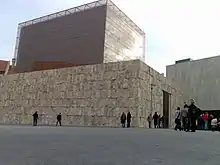Ohel Jakob synagogue (Munich)
Ohel Jakob (from Hebrew: "Jacob's Tent") is a synagogue in Munich, Germany. It was built between 2004 and 2006 as the new main synagogue for the Jewish community in Munich and is located at the Sankt-Jakobs-Platz. The synagogue was inaugurated on 9 November 2006 on the 68th anniversary of the Kristallnacht.[1] The building is part of the new Jewish Center consisting of the synagogue, the Jewish Museum Munich and a community center.
| Ohel Jakob synagogue | |
|---|---|
 The new main synagogue in Munich. | |
| Religion | |
| Affiliation | Judaism |
| Location | |
| Location | Munich, Germany |
 Shown within Germany | |
| Geographic coordinates | 48°8′4″N 11°34′21″E |
| Architecture | |
| Architect(s) | Rena Wandel-Hoefer and Wolfgang Lorch |
| Completed | 9 November 2006 |
| Materials | concrete, travertine stone |

Building
Ohel Jakob was designed by architects Rena Wandel-Hoefer and Wolfgang Lorch who were awarded the contract after an Architectural design competition on 6 July 2001.[2] The architects had previously completed the New Synagogue in Dresden. The topping out ceremony was celebrated on 25 October 2005. The opening ceremony was led by Charlotte Knobloch, president of Central Council of Jews in Germany and head of Munich's Orthodox Jewish community.
The building is a cubic concrete structure clad with travertine stone in its lower part and topped by a glass cube. The glass roof represents a tent (Ohel), symbolizing Moses' 40-year-journey through the desert. The main portal was manufactured in Budapest and features Hebrew letters depicting the Ten Commandments. The interior walls are paneled with warm cedar decorated with golden psalms.
The synagogue can seat 550 worshippers. It cost about €57 million (around US$72 million) to build and funding was provided by the city of Munich, the state of Bavaria, Munich's Jewish community and private donations.[3]
Munich's original main synagogue was destroyed in June 1938 and stood a few blocks away from the new synagogue, on ground that is now a parking ramp.
In 2003, German authorities uncovered a plot by a group of neo-Nazis to bomb the ceremony to lay the cornerstone for the building. Security concerns also led to the decision to house a memorial, to the more than 4,000 Jews of Munich who were killed in the Holocaust, in a tunnel between the synagogue and the Jewish community center.[3]
See also
References
| Wikimedia Commons has media related to Ohel Jakob synagogue. |
- "New Munich Synagogue Opens on Nazi Persecution Anniversary". Die Welt. 9 November 2006. Retrieved 31 January 2014.
- "Wettbewerbe". Jüdisches Zentrum Jakobsplatz München (in German). Retrieved 31 January 2014.
- "New Munich Synagogue Symbolizes Hope". Washington Post. 9 November 2006. Retrieved 31 January 2014.